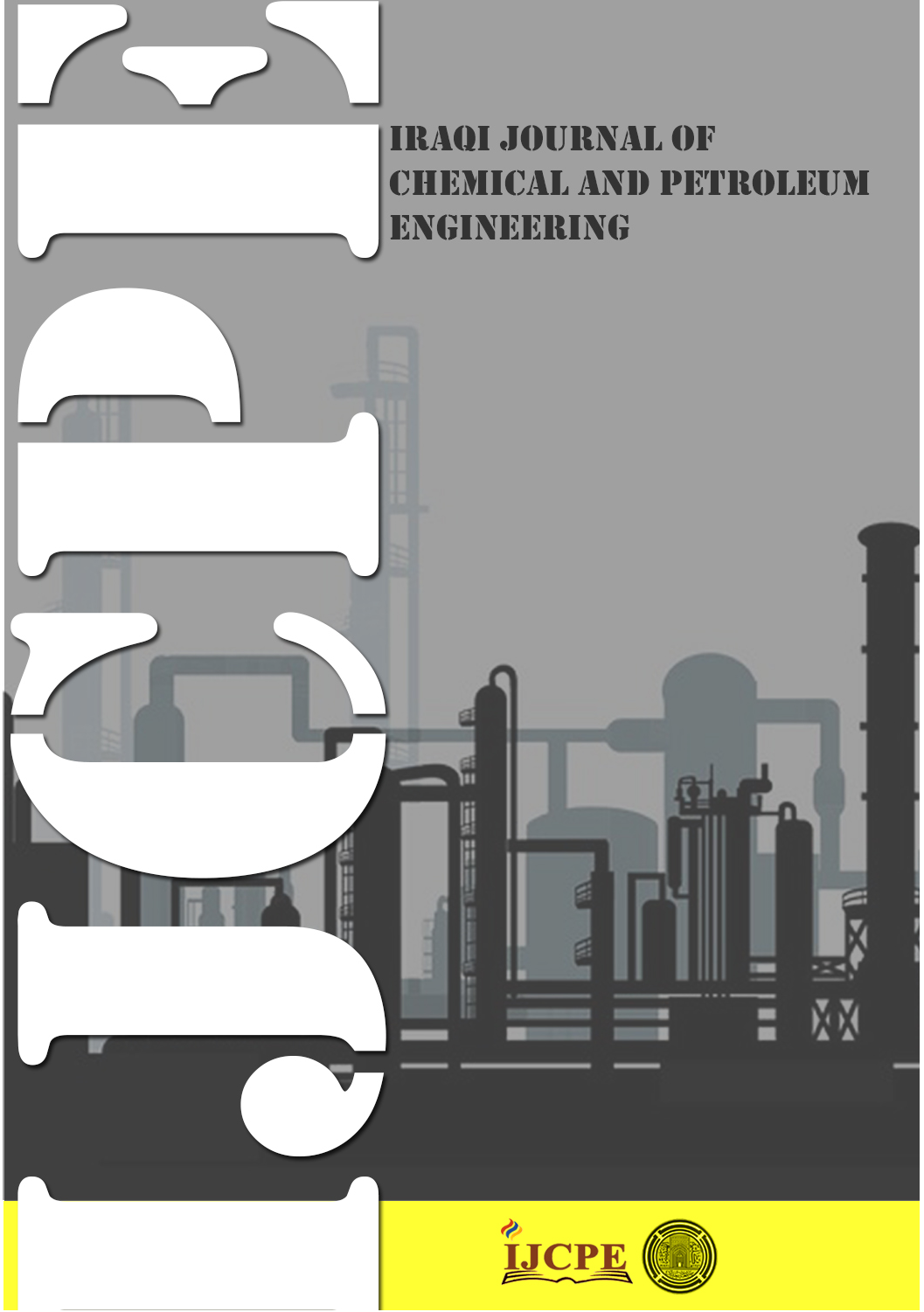CO2 hydrate formation enhancement via bare and hybrid silica nanoparticles effect: Implications for hydrate-based CO2 sequestration
DOI:
https://doi.org/10.31699/IJCPE.2025.2.2Keywords:
CO2 hydrates; carbon storage; silica nanoparticles; nanofluids; formation kineticsAbstract
Carbon dioxide geological storage gives tremendous promise for mitigating anthropogenic carbon emissions. CO2 hydrate has been given rising attention due to its potential in carbon geo-sequestration projects. The effect of silica nanoparticles (SiNPs) on the kinetics of CO2 hydrate formation was systematically studied at 3.5 MPa and 280 K. Pure (bare) and surface-modified (hybrid) SiNPs were separately characterized and used in this study. The effect of bare and hybrid SiNPs concentrations on the induction time of CO2 hydrate formation was investigated. A high-pressure, high-temperature stainless steel vessel was used as a hydrate reactor, and pressure-temperature data were continuously recorded to follow the hydrate formation process. Results revealed that the SiNPs significantly impact the kinetics of CO2 hydrate formation. The increase of Hybrid SiNPs concentration (>0.03 wt% hybrid SiNPs), significantly reduces the induction time and thus accelerates the rapid formation of CO2 hydrate. In contrast, bare SiNPs showed a lower effect on CO2 hydrate formation. Further, the increase of bare SiNPs (e.g., >0.07 wt% bare SiNPs) can tend to eliminate the effect of NPs on induction time. Thus, surface-modified SINPs can significantly enhance CO2 hydrate formation when formulated correctly.
Received on 13/04/2025
Received in Revised Form on 21/05/2025
Accepted on 23/05/2025
Published on 30/06/2025
References
[1] L. Zhang, Q. Zhou, Z. Wang, and W. Lu, "Experimental study on the flux-controlled growth of CO2-SO2 hydrates: Implications for hydrate-based CO2 sequestration," Chemical Engineering Science, vol. 298, p. 120369, 2024/10/05/ 2024. https://doi.org/10.1016/j.ces.2024.120369
[2] S. Iglauer, M. S. Mathew, and F. Bresme, "Molecular dynamics computations of brine–CO2 interfacial tensions and brine–CO2–quartz contact angles and their effects on structural and residual trapping mechanisms in carbon geo-sequestration," Journal of Colloid and Interface Science, vol. 386, no. 1, pp. 405-414, 11/15/ 2012. http://dx.doi.org/10.1016/j.jcis.2012.06.052
[3] S. F. J. Al-Anssari, "Application of Nanotechnology in Chemical Enhanced Oil Recovery and Carbon Storage," Curtin University, 2018.
[4] P. K. Bikkina, "Contact angle measurements of CO2–water–quartz/calcite systems in the perspective of carbon sequestration," International Journal of Greenhouse Gas Control, vol. 5, no. 5, pp. 1259-1271, 9// 2011. http://dx.doi.org/10.1016/j.ijggc.2011.07.001
[5] N. Kumar et al., "Carbon capture and sequestration technology for environmental remediation: A CO2 utilization approach through EOR," Geoenergy Science and Engineering, vol. 234, p. 212619, 2024/03/01/ 2024. https://doi.org/10.1016/j.geoen.2023.212619
[6] Q. Sun and Y. T. Kang, "Review on CO2 hydrate formation/dissociation and its cold energy application," Renewable and Sustainable Energy Reviews, vol. 62, pp. 478-494, 2016/09/01/ 2016. https://doi.org/10.1016/j.rser.2016.04.062
[7] J. J. Ramsden, I. J. Sokolov, and D. J. Malik, "Questioning the catalytic effect of Ni nanoparticles on CO2 hydration and the very need of such catalysis for CO2 capture by mineralization from aqueous solution," Chemical Engineering Science, vol. 175, pp. 162-167, 2018/01/16/ 2018. https://doi.org/10.1016/j.ces.2017.09.042
[8] M. Aminnaji et al., "CO2 Gas hydrate for carbon capture and storage applications – Part 1," Energy, vol. 300, p. 131579, 2024/08/01/ 2024. https://doi.org/10.1016/j.energy.2024.131579
[9] M. Aminnaji et al., "CO2 gas hydrate for carbon capture and storage applications – Part 2," Energy, vol. 300, p. 131580, 2024/08/01/ 2024. https://doi.org/10.1016/j.energy.2024.131580
[10] M. R. Walsh, C. A. Koh, E. D. Sloan, A. K. Sum, and D. T. Wu, "Microsecond simulations of spontaneous methane hydrate nucleation and growth," Science, vol. 326, no. 5956, pp. 1095-1098, 2009. https://doi.org/10.1126/science.1174010
[11] N. Adibi, M. Mohammadi, M. R. Ehsani, and E. Khanmohammadian, "Experimental investigation of using combined CH4/CO2 replacement and thermal stimulation methods for methane production from gas hydrate in the presence of SiO2 and ZnO nanoparticles," Journal of Natural Gas Science and Engineering, vol. 84, p. 103690, 2020/12/01/ 2020. https://doi.org/10.1016/j.jngse.2020.103690
[12] M. S. Sergeeva, A. N. Petukhov, D. N. Shablykin, N. A. Mokhnachev, I. V. Vorotyntsev, and V. M. Vorotyntsev, "INVESTIGATION OF THE GAS HYDRATE EQUILIBRIUM IN CH4 - CO2 - H2O MIXTURE IN THE PRESENCE OF THF - SDS PROMOTERS," Fluid Phase Equilibria, vol. 546, p. 113170, 2021/10/15/ 2021. https://doi.org/10.1016/j.fluid.2021.113170
[13] Y. Al‐okbi, S. Al‐Anssari, A. S. N. Al‐murshedi, S. K. M. Ibrahim, and R. Al‐Dujele, "Simulation and experimentation study on the performance of metal hydride storage vessels," International Journal of Energy Research, vol. 46, no. 4, pp. 4187-4203, 2022. https://doi.org/10.1002/er.7420
[14] X. Zhang, M. Zhang, P. Li, J. Li, Y. Wang, and Q. Wu, "Cooperative effect of surfactant and porous media on CO2 hydrate formation and capacity of gas storage," Fuel, vol. 329, p. 125494, 2022/12/01/ 2022. https://doi.org/10.1016/j.fuel.2022.125494
[15] S. Sinehbaghizadeh, A. Saptoro, and A. H. Mohammadi, "CO2 hydrate properties and applications: A state of the art," Progress in Energy and Combustion Science, vol. 93, p. 101026, 2022/11/01/ 2022. https://doi.org/10.1016/j.pecs.2022.101026
[16] K. Zhang and H. C. Lau, "Sequestering CO2 as CO2 hydrate in an offshore saline aquifer by reservoir pressure management," Energy, vol. 239, p. 122231, 2022/01/15/ 2022. https://doi.org/10.1016/j.energy.2021.122231
[17] L. Jiao, R. Wan, and Z. Wang, "Experimental investigation of CO2 hydrate formation in silica nanoparticle system under static conditions," Journal of Crystal Growth, vol. 583, p. 126539, 2022/04/01/ 2022. https://doi.org/10.1016/j.jcrysgro.2022.126539
[18] F. Wang et al., "Dynamic mechanism of CO2 capture from flue gas via hydrate-based method induced by using IB group transition metal functionalized carbon nanotubes," Gas Science and Engineering, vol. 128, p. 205392, 2024/08/01/ 2024. https://doi.org/10.1016/j.jgsce.2024.205392
[19] S. Jia et al., "Rapid growth of CO2 hydrate as a promising way to mitigate the greenhouse effect," Materials Today Physics, vol. 48, p. 101548, 2024/11/01/ 2024. https://doi.org/10.1016/j.mtphys.2024.101548
[20] S. Ma et al., "Formation and decomposition characteristics of CO2+TBAB hydrate for a safer CO2 storage," Energy, vol. 307, p. 132801, 2024/10/30/ 2024. https://doi.org/10.1016/j.energy.2024.132801
[21] A. Kumar, T. Sakpal, P. Linga, and R. Kumar, "Influence of contact medium and surfactants on carbon dioxide clathrate hydrate kinetics," Fuel, vol. 105, pp. 664-671, 2013/03/01/ 2013. https://doi.org/10.1016/j.fuel.2012.10.031
[22] Y.-s. Yu, C.-g. Xu, and X.-s. Li, "Evaluation of CO2 hydrate formation from mixture of graphite nanoparticle and sodium dodecyl benzene sulfonate," Journal of Industrial and Engineering Chemistry, vol. 59, pp. 64-69, 2018/03/25/ 2018. https://doi.org/10.1016/j.jiec.2017.10.007
[23] X. Zang, L. Wan, Y. He, and D. Liang, "CO2 removal from synthesized ternary gas mixtures used hydrate formation with sodium dodecyl sulfate(SDS) as additive," Energy, vol. 190, p. 116399, 2020/01/01/ 2020. https://doi.org/10.1016/j.energy.2019.116399
[24] X. Liu, J. Ren, D. Chen, and Z. Yin, "Comparison of SDS and L-Methionine in promoting CO2 hydrate kinetics: Implication for hydrate-based CO2 storage," Chemical Engineering Journal, vol. 438, p. 135504, 2022/06/15/ 2022. https://doi.org/10.1016/j.cej.2022.135504
[25] S. Al-Anssari, A. Barifcani, S. Wang, M. Lebedev, and S. Iglauer, "Wettability alteration of oil-wet carbonate by silica nanofluid," Journal of Colloid and Interface Science, vol. 461, pp. 435-442, 1/1/ 2016. http://dx.doi.org/10.1016/j.jcis.2015.09.051
[26] M. Mahdi, S. Al-Anssari, and Z.-U.-A. Arain, "Influence of nanofluid flooding on oil displacement in porous media," Iraqi Journal of Chemical and Petroleum Engineering, vol. 24, no. 2, pp. 19-30, 2023. https://doi.org/10.31699/IJCPE.2023.2.3
[27] S. Al-Anssari, M. Arif, S. Wang, A. Barifcani, M. Lebedev, and S. Iglauer, "CO2 geo-storage capacity enhancement via nanofluid priming," International Journal of Greenhouse Gas Control, vol. 63, pp. 20-25, 2017. https://doi.org/10.1016/j.ijggc.2017.04.015
[28] S.-D. Zhou et al., "The synergistic promotion of L-methionine combined with multi-walled carbon nanotubes on CO2 hydrate formation kinetics," Journal of Industrial and Engineering Chemistry, vol. 138, pp. 282-299, 2024/10/25/ 2024. https://doi.org/10.1016/j.jiec.2024.04.004
[29] S. Chol, "Enhancing thermal conductivity of fluids with nanoparticles," ASME-Publications-Fed, vol. 231, pp. 99-106, 1995.
[30] J. Li, D. Liang, K. Guo, R. Wang, and S. Fan, "Formation and dissociation of HFC134a gas hydrate in nano-copper suspension," Energy Conversion and Management, vol. 47, no. 2, pp. 201-210, 2006/01/01/ 2006. https://doi.org/10.1016/j.enconman.2005.03.018
[31] V. D. Chari, D. V. S. G. K. Sharma, P. S. R. Prasad, and S. R. Murthy, "Methane hydrates formation and dissociation in nano silica suspension," Journal of Natural Gas Science and Engineering, vol. 11, pp. 7-11, 2013/03/01/ 2013. https://doi.org/10.1016/j.jngse.2012.11.004
[32] M. Mohammadi, A. Haghtalab, and Z. Fakhroueian, "Experimental study and thermodynamic modeling of CO2 gas hydrate formation in presence of zinc oxide nanoparticles," The Journal of Chemical Thermodynamics, vol. 96, pp. 24-33, 2016/05/01/ 2016. https://doi.org/10.1016/j.jct.2015.12.015
[33] Y.-s. Yu, S.-d. Zhou, X.-s. Li, and S.-l. Wang, "Effect of graphite nanoparticles on CO2 hydrate phase equilibrium," Fluid Phase Equilibria, vol. 414, pp. 23-28, 2016/04/25/ 2016. https://doi.org/10.1016/j.fluid.2015.12.054
[34] Z. Cheng et al., "Effect of nanoparticles as a substitute for kinetic additives on the hydrate-based CO2 capture," Chemical Engineering Journal, vol. 424, p. 130329, 2021/11/15/ 2021. https://doi.org/10.1016/j.cej.2021.130329
[35] S. Kim, A. H. Zadeh, M. Nole, H. Daigle, C. Huh, and I. Kim, "Spontaneous generation of stable CO2 emulsions via the dissociation of nanoparticle-aided CO2 hydrate," Journal of Petroleum Science and Engineering, vol. 208, p. 109203, 2022/01/01/ 2022. https://doi.org/10.1016/j.petrol.2021.109203
[36] A. Mohammadi, M. Manteghian, A. Haghtalab, A. H. Mohammadi, and M. Rahmati-Abkenar, "Kinetic study of carbon dioxide hydrate formation in presence of silver nanoparticles and SDS," Chemical Engineering Journal, vol. 237, pp. 387-395, 2014/02/01/ 2014. https://doi.org/10.1016/j.cej.2013.09.026
[37] H. Pahlavanzadeh, M. Khanlarkhani, S. Rezaei, and A. H. Mohammadi, "Experimental and modelling studies on the effects of nanofluids (SiO2, Al2O3, and CuO) and surfactants (SDS and CTAB) on CH4 and CO2 clathrate hydrates formation," Fuel, vol. 253, pp. 1392-1405, 2019/10/01/ 2019. https://doi.org/10.1016/j.fuel.2019.05.010
[38] S. Rajabi Firoozabadi and M. Bonyadi, "A comparative study on the effects of Fe3O4 nanofluid, SDS and CTAB aqueous solutions on the CO2 hydrate formation," Journal of Molecular Liquids, vol. 300, p. 112251, 2020/02/15/ 2020. https://doi.org/10.1016/j.molliq.2019.112251
[39] D. Bai, G. Chen, X. Zhang, A. K. Sum, and W. Wang, "How properties of solid surfaces modulate the nucleation of gas hydrate," Scientific reports, vol. 5, no. 1, p. 12747, 2015. https://doi.org/10.1038/srep12747
[40] N. N. Nguyen, A. V. Nguyen, K. M. Steel, L. X. Dang, and M. Galib, "Interfacial Gas Enrichment at Hydrophobic Surfaces and the Origin of Promotion of Gas Hydrate Formation by Hydrophobic Solid Particles," The Journal of Physical Chemistry C, vol. 121, no. 7, pp. 3830-3840, 2017/02/23 2017. https://doi.org/10.1021/acs.jpcc.6b07136
[41] I. Kim et al., "Highly porous CO2 hydrate generation aided by silica nanoparticles for potential secure storage of CO2 and desalination," RSC Advances, 10.1039/C6RA26366F vol. 7, no. 16, pp. 9545-9550, 2017. https://doi.org/10.1039/C6RA26366F
[42] R. Wang et al., "Effect of hydrophilic silica nanoparticles on hydrate formation: Insight from the experimental study," Journal of Energy Chemistry, vol. 30, pp. 90-100, 2019/03/01/ 2019. https://doi.org/10.1016/j.jechem.2018.02.021
[43] J. Min, D. W. Kang, W. Lee, and J. W. Lee, "Molecular Dynamics Simulations of Hydrophobic Nanoparticle Effects on Gas Hydrate Formation," The Journal of Physical Chemistry C, vol. 124, no. 7, pp. 4162-4171, 2020/02/20 2020. https://doi.org/10.1021/acs.jpcc.9b11459
[44] Z.-U. L. A. Arain et al., "Reversible and irreversible adsorption of bare and hybrid silica nanoparticles onto carbonate surface at reservoir condition," Petroleum, vol. 6, no. 3, pp. 277-285, 2020/09/01/ 2020. https://doi.org/10.1016/j.petlm.2019.09.001
[45] J. W. Grate et al., "Correlation of Oil–Water and Air–Water Contact Angles of Diverse Silanized Surfaces and Relationship to Fluid Interfacial Tensions," Langmuir, vol. 28, no. 18, pp. 7182-7188, 2012/05/08 2012. https://doi.org/10.1021/la204322k
[46] W. He et al., "Surface modification of colloidal silica nanoparticles: Controlling the size and grafting process," Bulletin of the Korean Chemical Society, vol. 34, no. 9, pp. 2747-2752, 2013. https://doi.org/10.5012/bkcs.2013.34.9.2747
[47] G. London, G. T. Carroll, and B. L. Feringa, "Silanization of quartz, silicon and mica surfaces with light-driven molecular motors: construction of surface-bound photo-active nanolayers," Organic & Biomolecular Chemistry, 10.1039/C3OB40276B vol. 11, no. 21, pp. 3477-3483, 2013. https://doi.org/10.1039/C3OB40276B
[48] P. Rostamzadeh, S. M. Mirabedini, and M. Esfandeh, "APS-silane modification of silica nanoparticles: effect of treatment’s variables on the grafting content and colloidal stability of the nanoparticles," Journal of Coatings Technology and Research, journal article vol. 11, no. 4, pp. 651-660, 2014. https://doi.org/10.1007/s11998-014-9577-8
[49] S. Al-Anssari, M. Arif, S. Wang, A. Barifcani, and S. Iglauer, "Stabilising nanofluids in saline environments," Journal of Colloid and Interface Science, vol. 508, pp. 222-229, 2017. https://doi.org/10.1016/j.jcis.2017.08.043
[50] N. Bajpai, A. Tiwari, S. Khan, R. Kher, N. Bramhe, and S. Dhoble, "Effects of rare earth ions (Tb, Ce, Eu, Dy) on the thermoluminescence characteristics of sol–gel derived and γ‐irradiated SiO2 nanoparticles," Luminescence, vol. 29, no. 6, pp. 669-673, 2014. https://doi.org/10.1002/bio.2604
[51] S. Al-Anssari et al., "Synergistic effect of nanoparticles and polymers on the rheological properties of injection fluids: implications for enhanced oil recovery," Energy & Fuels, vol. 35, no. 7, pp. 6125-6135, 2021. https://doi.org/10.1021/acs.energyfuels.1c00105
[52] S. Al-Anssari, A. Barifcani, A. Keshavarz, and S. Iglauer, "Impact of nanoparticles on the CO2-brine interfacial tension at high pressure and temperature," Journal of Colloid and Interface Science, vol. 532, pp. 136-142, 2018/12/15/ 2018. https://doi.org/10.1016/j.jcis.2018.07.115
[53] S. Al-Anssari, H. A. Shanshool, A. Keshavarz, and M. Sarmadivaleh, "Synergistic effect of hydrophilic nanoparticles and anionic surfactant on the stability and viscoelastic properties of oil in water (o/w) emulations; application for enhanced oil recovery (EOR)," Journal of Petroleum Research and Studies, vol. 10, no. 4, pp. 33-53, 2020. https://doi.org/10.52716/jprs.v10i4.366
[54] S. Al-Anssari, Z.-U. L. A. Arain, A. Barifcani, A. Keshavarz, M. Ali, and S. Iglauer, "Influence of Pressure and Temperature on CO2-Nanofluid Interfacial Tension: Implication for Enhanced Oil Recovery and Carbon Geosequestration," presented at the Abu Dhabi International Petroleum Exhibition & Conference, Abu Dhabi, UAE, 2018/11/12/, 2018. https://doi.org/10.2118/192964-MS
Downloads
Published
Issue
Section
License
Copyright (c) 2025 The Author(s). Published by College of Engineering, University of Baghdad.

This work is licensed under a Creative Commons Attribution 4.0 International License.













